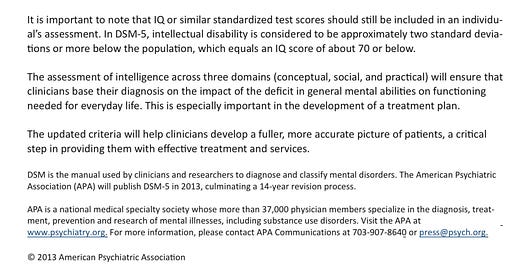It was winter, 1979. Paul at seventeen stood awkwardly near the front door in the lobby of the Napa Reading Clinic.
It was as if he feared something.
He cowered a bit, shoulders drooped, his silence expressive, eye contact grudging.
“Paul, this man could help you,” his mother said with a hint of exasperation. “I’m sorry. He’s usually better.”
“Paul, I like your name,” I said. “Let’s sit down, ok?”
In early childhood Paul was medically diagnosed as mentally retarded1, renamed and reconceptualized in the current DSM-5 as ‘intellectually disabled2.’
The change in terminology underscores our collective awareness that assessment should speak to the future and should develop from a mixed-methods approach.
Paul’s mother, a woman in her early sixties, narrated his diagnostic milestones in a practiced tone. Paul became calmer as she talked.
He crawled and walked at fifteen months, a small worry, but language, the big worry, was trouble. He was forty months when he first spoke a recognizable word.
In first and second grade Paul surprised everyone by learning to identify letters. He looked perfectly normal though his social behavior was a bit odd. He gradually learned to recognize a collection of words by sight, including the long word ‘hamburger.’
He had an optimistic school psychologist in sixth grade, Paul’s cheerleader. His Individual Education Plan listed reading as an area of continued focus.
Junior high changed the focus.
Paul would never learn to read, they said in seventh grade. Time would be better spent in other areas of instruction. His mother signed the IEP, spelling out goals and the least restrictive environment for her son in accordance with recent legislation, but she felt as if she were giving up on her him.
Walking the halls of junior high and high school, she said, her son carried books under his arm.
Paul’s mother brought him to my clinic on a friend’s referral. I had helped her daughter, a fourth grader. Something clicked in her brain; she grew from an early second grade assessed level to a late third grade in five months. Maybe Paul would click.
Paul and I went into a tutoring room where I talked with him and did an intake assessment.
I learned that mother’s information was accurate. He automatically recognized most lower-case letters, some upper-case, and a handful of Dolch sight words.
This learning was hard won, the contribution of his teachers during elementary school in an affluent neighborhood. Kurt, my teaching reading teacher, taught me that struggling readers must overlearn letters and high-frequency words and word parts to the point of saturation—impossible to forget.
Paul could not read aloud the pre-primer passage of the Gray Oral Fluency Test, not even barking the words. He could search the text and identify letters by name. He could point to spaces between words. He could point to individual words and identify a few sight words in running text.
But he was unable to begin and sustain an intake of visual cues to program his mouth to produce anything resembling speech matching text. He had no eye-voice connection.
He could, however, grasp the sense of the passage read aloud for him. If he could find his way from text to language, he could comprehend meaning through reading.
I worked with Paul for three months. Language Experience was excruciating. Paul had trouble connecting words he had dictated and I had transcribed to the words he had originally spoken. It was bizarre.
Neurological Impress3 was ineffective, I think because he could not visually track print as he listened to it read aloud.
A focus on consonant-vowel-consonant words in isolation for a few weeks yielded results, with instances of auditory closure, but without focused supervision and scaffolding, the letter-name strategy he could use with my help was too complex for independent application.
Paul did not learn to decode words with enough speed and staying power in short term memory to microprocess sense within grammatical frames with enough alacrity to construct a syntactic or semantic micro context at the literal level. He couldn’t backfill noun-verb structures he controlled in speaking and listening with printed words.
It was getting harder for him to sustain joint attention during sessions as the weeks passed. He would bounce his feet, shaking the table. He would rub himself in the groin area under the table, his eyes glazing.
His mother was upset and said to tell him to stop. “He knows it’s not appropriate.” I did. He stopped.
I “retested” Paul on pre-primer material. The name recognition of letters he arrived with served as a foundation for his learning to articulate phonemes—“m” says “mmmm.” He had increased his sight vocabulary by a handful of words. ‘Hamburger’ was still his favorite.
But there was no miracle.
Fragments of visual and auditory symbols floated in Paul’s consciousness when he read, haphazardly tied to meaning, but no force existed to pull together a line of thought riding on a coherent stream of cues.
He could process speech at a rudimentary level, receive and respond to message, comprehend, learn new things, but he could not read print. The alphabetic principle was out of useful reach.
In my doctoral program at UC Davis fifteen years later I thought of Paul when I read about Vygotsky’s notion of psychological tools invented or learned in service of psychological functions. Vygotsky classified psychological functions into lower order and higher order.
Functions like perception, memory, and attention are lower-order, biological, originating inside the human organism; functions like language, logic, planning, and decision-making are higher-order, sociocultural and historical, transferred inside the human being through learning.
Paul couldn’t link lower-order perception and memory of tools like letters and punctuation marks to higher-order functions like language and logic as tools to make meaning.
Leaping the divide between these functions using print as a mediating tool to activate language appeared beyond Paul’s level of intellectual ability—or beyond my level of expertise to teach him.
https://www.aafp.org/pubs/afp/issues/2000/0215/p1059.html
https://www.psychiatry.org/File%20Library/Psychiatrists/Practice/DSM/APA_DSM-5-Intellectual-Disability.pdf
https://nysrti.org/intervention-tools/reading-tools/tool:neurological-impress-method/











Thanks so much for that explanation, Terry. The impact Vygotsky had on you in your teaching is awesome. I agree with the usefulness of good theory — and attempting to apply theory or successfully applying theory is admirable. Thanks for your take on the issue of scientific research. That is helpful as well. Back to theory applied to organizational change — I have been a big believer and “user” of Kurt Lewin’s Force Field Analysis. His “life space” concept is also intriguing. Thanks again.
Terry — I am intrigued (on many levels) with your posting that describes your work with Paul. I see myself as a practitioner of teaching and also of organizational change, management, and leadership — with a focus on primary/elementary literacy. One of the thoughts that occurred to me as I read the steps and strategies you used with Paul and the results of their use is that this is what sounds like grounded research. That is, you were working with a child, sharing strategies and reporting on outcomes. This kind of grounded research seems to fit the ethnographic or anthropological methods of research more than the type of research that comes out of the natural sciences. My take is that this type of research is helpful to practitioners whereas much of the educational psychology research that utilizes the methods of natural science are of very little help to me as a practitioner (teacher, principal, consultant, coach, etc.). On another note, you have documented a case where certain strategies, concepts, and instruments did not work with a child who appeared to have some intellectual disabilities. In my postings on The Emotionally Healthy Literacy Classroom newsletter I will attempt to share some specific strategies that I believe can help children like Paul. I have tested these strategies in real classrooms and will report ion them. Thanks for sharing your experiences, insights, and ideas. Lastly, I also enjoyed the Vygotsky reference although I did not completely understand how it applies to a practitioner’s situation — but I do very much appreciate Vygotsky’s observation that what a child can do with help today, he will be able to do on his own tomorrow (or soon). Thanks again for sharing.